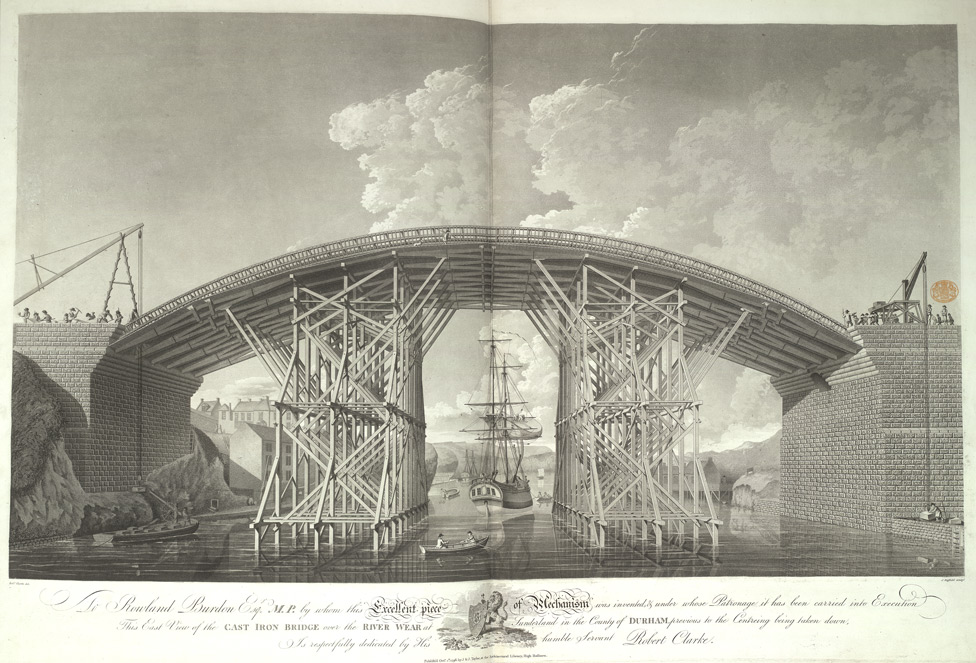Wearmouth Bridge (1796) on:
[Wikipedia]
[Google]
[Amazon]
The first Wearmouth Bridge was the second major bridge to be made from
 The foundation stone was laid in September 1793.
It is possible that two of the six main ribs used in the Wearmouth bridge, were created from the actual ribs used by Paine in his prototype, which had been returned to the Foundry in Rotherham where the ribs of both bridges were cast.
The bridge was opened in 1796.
The foundation stone was laid in September 1793.
It is possible that two of the six main ribs used in the Wearmouth bridge, were created from the actual ribs used by Paine in his prototype, which had been returned to the Foundry in Rotherham where the ribs of both bridges were cast.
The bridge was opened in 1796.
 From 1857 to 1859 it was reconstructed by
From 1857 to 1859 it was reconstructed by
cast iron
Cast iron is a class of iron– carbon alloys with a carbon content more than 2%. Its usefulness derives from its relatively low melting temperature. The alloy constituents affect its color when fractured: white cast iron has carbide impur ...
. It was considered one of the wonders of the industrial age, and was described by Nikolaus Pevsner
Sir Nikolaus Bernhard Leon Pevsner (30 January 1902 – 18 August 1983) was a German-British art historian and architectural historian best known for his monumental 46-volume series of county-by-county guides, ''The Buildings of England'' (1 ...
as being 'a triumph of the new metallurgy and engineering ingenuity ..of superb elegance'.
Design
The bridge was instigated, sponsored and patented by Rowland Burdon, theMember of Parliament
A member of parliament (MP) is the representative in parliament of the people who live in their electoral district. In many countries with bicameral parliaments, this term refers only to members of the lower house since upper house members o ...
for County Durham, and built under the direction of Thomas Wilson, who designed its architectural features.
It was the second iron bridge built after The Iron Bridge
The Iron Bridge is a cast iron arch bridge that crosses the River Severn in Shropshire, England. Opened in 1781, it was the first major bridge in the world to be made of cast iron. Its success inspired the widespread use of cast iron as a st ...
, but was over twice as long with a nominal span of , and only three-quarters the weight. Indeed, at the time of building, it was the biggest single-span bridge in the world (72 m), matching the collapsed Trezzo Bridge.
The decision to use cast iron was strongly influenced by Thomas Paine
Thomas Paine (born Thomas Pain; – In the contemporary record as noted by Conway, Paine's birth date is given as January 29, 1736–37. Common practice was to use a dash or a slash to separate the old-style year from the new-style year. In th ...
, who had constructed a demonstration cast iron span of comparable length in Paddington in 1789, and had submitted models and designs for Wearmouth.
Construction
 The foundation stone was laid in September 1793.
It is possible that two of the six main ribs used in the Wearmouth bridge, were created from the actual ribs used by Paine in his prototype, which had been returned to the Foundry in Rotherham where the ribs of both bridges were cast.
The bridge was opened in 1796.
The foundation stone was laid in September 1793.
It is possible that two of the six main ribs used in the Wearmouth bridge, were created from the actual ribs used by Paine in his prototype, which had been returned to the Foundry in Rotherham where the ribs of both bridges were cast.
The bridge was opened in 1796.
Impact
According to the plaque on the current bridge, its construction "proved to be a catalyst for the growth of Sunderland," since access betweenMonkwearmouth
Monkwearmouth is an area of Sunderland, Tyne and Wear in North East England. Monkwearmouth is located at the north side of the mouth of the River Wear. It was one of the three original settlements on the banks of the River Wear along with Bish ...
and Bishopwearmouth
Bishopwearmouth is a former village and parish which now constitutes the west side of Sunderland City Centre, merging with the settlement as it expanded outwards in the 18th and 19th centuries. It is home to the Sunderland Minster church, which ...
had previously only been by ferry, with the nearest bridge at Chester-le-Street
Chester-le-Street (), also known as Chester, is a market town and civil parish in County Durham, England, around north of Durham and also close to Sunderland and Newcastle upon Tyne. It is located on the River Wear, which runs out to sea at ...
.
Operation
It opened to traffic on 9 August 1796, having cost a total of about £28,000. There was originally a toll for traffic and pedestrians, although tolls for pedestrians were abolished in 1846.1805 repair
In 1805 the bridge had to be repaired after heat from the sun caused some of the cross tubes to fall out.1857 reconstruction
 From 1857 to 1859 it was reconstructed by
From 1857 to 1859 it was reconstructed by Robert Stephenson
Robert Stephenson FRS HFRSE FRSA DCL (16 October 1803 – 12 October 1859) was an English civil engineer and designer of locomotives. The only son of George Stephenson, the "Father of Railways", he built on the achievements of his father ...
, who stripped the bridge back to its six iron ribs and levelled the roadway by raising the abutments. The bridge was reopened in March 1859, with the toll completely abolished in 1885.
Further reading
*References
{{Thomas Paine Cast-iron arch bridges in England Bridges across the River Wear Bridges completed in 1796 1796 establishments in Great Britain